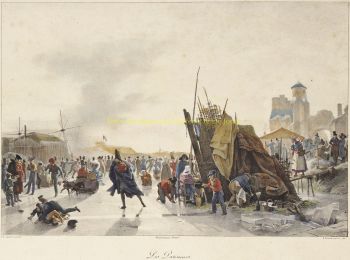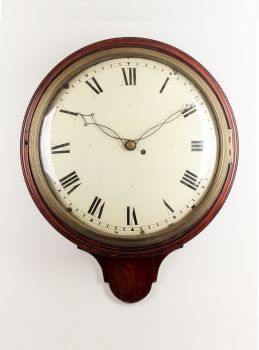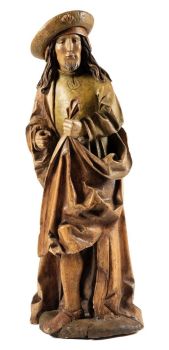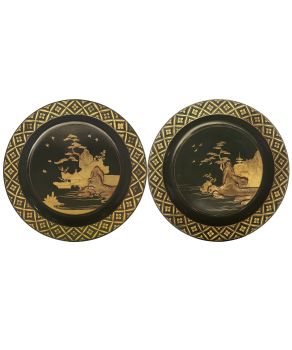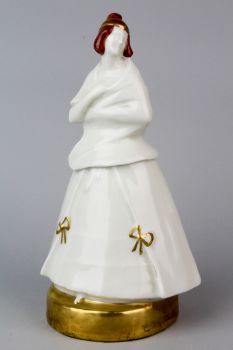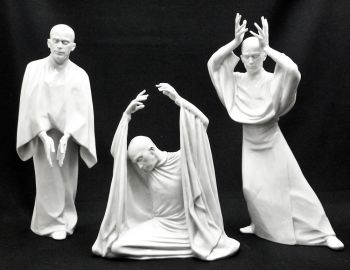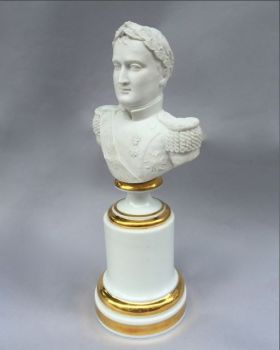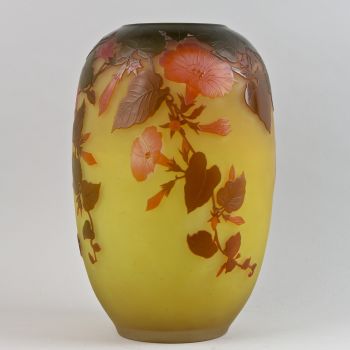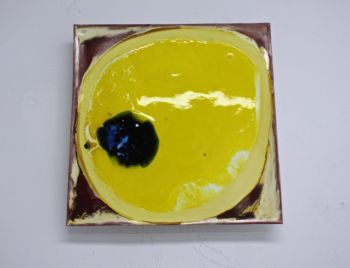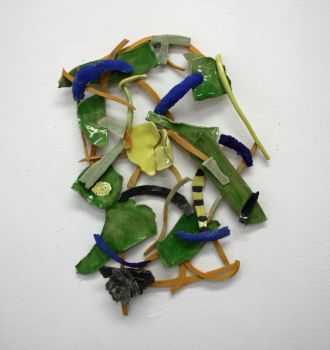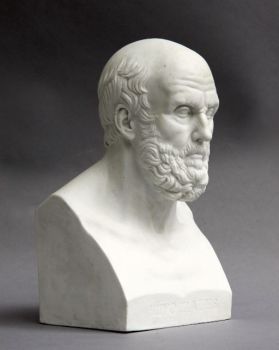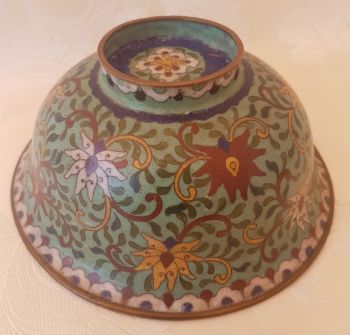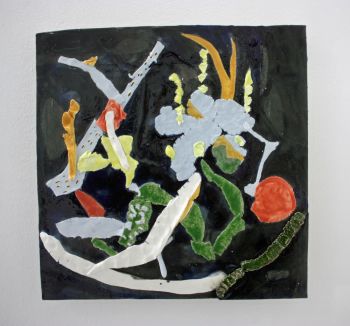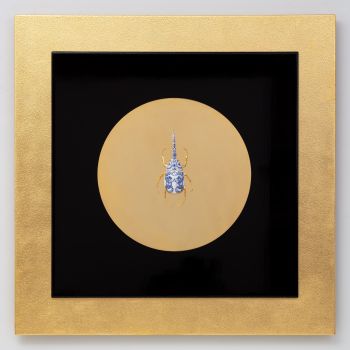A large Japanese porcelain blue and white bowl, Arita, Edo period, c. 1660-1680 1660 - 1680
Unknown artist
Japanese PorcelainPorcelain
12.80 cm, ø 32 cm
ConditionVery good
Price on request
Menken Works of Art
- About the artworkA large blue and white bowl with floral decoration.
Japan, Arita, Edo period, c. 1660-1680.
The large bowl with a bulbous body, spreading sides and everted rim, almost of klapmuts shape, decorated in underglaze blue with large flowering chrysanthemums (菊 kiku) with leaves, the rim with a band of foliate (唐草 karakusa) scrolls, the inside decorated with a pot from which chrysanthemum flowers emerge, set against the background of a fenced garden courtyard. The outer rim has a deep cobalt border (almost of a black tone), fluxing inwards. The bowl is supported on a high footring, the base with a circle in underglaze blue, around the outside of the foot with a triple blue line.
Although some types of chrysanthemum begin flowering in the summer, the chrysanthemum is primarily an indication of autumn. Like many autumn motifs, the chrysanthemum evokes feelings of melancholy in Japan.
The flowerpot (花盆 kabon) motif was used on the first Japanese export porcelain in the mid-17th century and comes from Chinese Kraak porcelain.
Ref:
A blue and white shaving bowl with an exact similar decoration of a flowerpot with chrysanthemum and of the same style, dated by the author to the Kanbun period (1661-1673) is in the Groninger Museum collection and published in: A Survey of Japanese Ceramics (Maria Penkala, 1980), p. 188.
A large blue and white bowl of the same shape is in the collection of August the Strong, Dresden, SKD Museum, registration no. PO 954
For other large blue and white bowls of the same shape, see: Porcelain for Palaces (John Ayers, Oliver Impey and J.V.G. Mallet, 1990), p. 100, pl. 44 and p. 109, pl. 59
For an explanation on the chrysanthemum symbolism and the origin of the flowerpot on Japanese ceramics, see: Kakiemon Porcelain (Menno Fitski, 2011), p. 149.
Dimensions:
Diameter 32 cm, height 12.8 cm.
Condition:
Very good condition, without damages.
Inv. No: MW99 - About the artist
It might happen that an artist or maker is unknown.
Some works are not to be determined by whom it is made or it is made by (a group of) craftsmen. Examples are statues from the Ancient Time, furniture, mirroirs, or signatures that are not clear or readible but as well some works are not signed at all.
As well you can find the following description:
•“Attributed to ….” In their opinion probably a work by the artist, at least in part
•“Studio of ….” or “Workshop of” In their opinion a work executed in the studio or workshop of the artist, possibly under his supervision
•“Circle of ….” In their opinion a work of the period of the artist showing his influence, closely associated with the artist but not necessarily his pupil
•“Style of ….” or “Follower of ….” In their opinion a work executed in the artist’s style but not necessarily by a pupil; may be contemporary or nearly contemporary
•“Manner of ….” In their opinion a work in the style of the artist but of a later date
•“After ….” In their opinion a copy (of any date) of a work of the artist
•“Signed…”, “Dated….” or “Inscribed” In their opinion the work has been signed/dated/inscribed by the artist. The addition of a question mark indicates an element of doubt
•"With signature ….”, “With date ….”, “With inscription….” or “Bears signature/date/inscription” in their opinion the signature/ date/ inscription has been added by someone other than the artist
Are you interested in buying this artwork?
Artwork details
Related artworks
- 1 - 4 / 12
Unknown artist
A SMALL IVORY NETSUKE OF A DUTCHMAN WITH A DRUM1750 - 1800
Price on requestZebregs & Röell - Fine Art - Antiques
Unknown artist
A RARE LARGE JAPANESE LACQUERED LEATHER TELESCOPE1750 - 1800
Price on requestZebregs & Röell - Fine Art - Antiques
Unknown artist
A JAPANESE SMALL SAWASA 'PEACH-FORM' CRUCIBLE CUPearly 18th
Price on requestZebregs & Röell - Fine Art - Antiques
Unknown artist
A IVORY NETSUKE OF A DUTCHMAN HOLDING A COCKEREL18th century
Price on requestZebregs & Röell - Fine Art - Antiques
Unknown artist
A rare Japanese export lacquer medical instrument box1650 - 1700
Price on requestZebregs & Röell - Fine Art - Antiques
Unknown artist
AN IVORY NETSUKE OF A DUTCHMAN FROLICKING WITH A SMALL BOY18th century
Price on requestZebregs & Röell - Fine Art - Antiques
Unknown artist
A MARINE IVORY NETSUKE OF A DUTCHMAN HOLDING A CHINESE FAN18th century
Price on requestZebregs & Röell - Fine Art - Antiques
Unknown artist
The Stamford Raffles Secretaires.1800 - 1813
Price on requestZebregs & Röell - Fine Art - Antiques
1 - 4 / 22- 1 - 4 / 24
Unknown artist
Series of 6 Chinese cups and saucers (Yongzheng period)1722 - 1735
Price on requestKuipers Kunst & Antiek
Unknown artist
A large Japanese Imari porcelain 'VOC Groningen' dish1800 - 1925
Price on requestZebregs & Röell - Fine Art - Antiques
Samuel Dejong
Anatomia Blue Heritage, Atlas Closed2017 - 2019
Price on requestVilla del Arte Galleries
1 - 4 / 24Unknown artist
A white jade ‘Lotus Seedpod and Bug’ carving, Qing dynasty, 18th century18th century
Price on requestMenken Works of Art
Unknown artist
Chinese gilt bronze censer, Xuande mark, 18th century, Qing dynasty18th century
Price on requestMenken Works of Art
1 - 4 / 10









